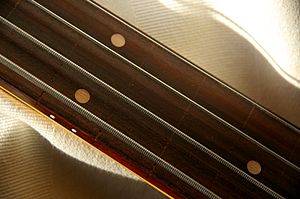Strings (music) facts for kids
A string in music is a special kind of string used on musical instruments like guitars, pianos, and violins. These strings are made from different materials like steel, nylon, or even animal gut. When you pluck, bow, or strike a string, it vibrates very fast, creating the sounds we hear. To make sure they vibrate well, strings are usually stretched tightly, which is called being under tension.
Contents
What Are Musical Strings?
Musical strings are essential parts of many instruments. They are carefully designed to produce clear and beautiful sounds. The way a string is made, its material, and how tightly it's stretched all affect the sound it makes.
How Do Strings Make Sound?
When a musician plays an instrument, they make the strings move back and forth very quickly. This fast movement is called vibration. These vibrations create sound waves that travel through the air to our ears. The tighter a string is, or the thinner it is, the faster it vibrates, making a higher-pitched sound. Thicker or looser strings vibrate slower, making lower sounds.
Materials Used for Strings
Strings can be made from different materials, and each material gives a unique sound:
- Steel strings are very common, especially on guitars and pianos. They produce a bright, clear sound.
- Nylon strings are often used on classical guitars and ukuleles. They give a softer, warmer sound.
- Gut strings were traditionally made from animal intestines. They are still used on some historical instruments and violins for a rich, complex tone.
- Sometimes, strings are wound with a thin wire around a core. This makes them heavier without being too thick, which helps them produce lower notes.
Images for kids
See also
 In Spanish: Cuerda (música) para niños
In Spanish: Cuerda (música) para niños





